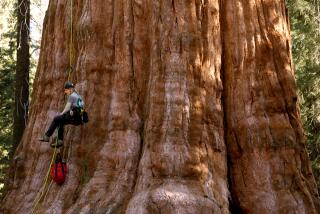Conservation Groups Show Interest : Study of Virgin Woods Starting in Northeast
- Share via
CHARLOTTE, Vt. — New England’s woods have been cut by man many times over. Even in the remote northern forests near Canada, the stands of trees are almost all second- and third-generation timber.
Oak has been sought for shipbuilding, hemlock for tanning, hardwoods for furniture, and spruce and fir for paper making. Wind, insects, fire and lightning have been less discriminating, toppling all species.
But roughly two dozen New England forest stands such as Williams Woods, a 65-acre parcel in this Champlain Valley town, have survived untouched over the centuries.
These are virgin forests, and conservancy groups in the region are beginning to take notice. Studies on the original forests recently were completed in Vermont, New Hampshire and Maine, and state officials and environmentalists are contacting landowners or buying the land to ensure that the forests continue to serve as a link with the distant past.
‘History Books’
“These trees are history books, and we are just starting to learn how to read them,” said Marc Desmeules, an ecologist with the Vermont chapter of the Nature Conservancy, a nationwide land-trust group. “If we really want to understand how forests work, we need to have completely undisturbed forests.”
Although efforts to locate and preserve virgin forests in the West have been going on for generations, environmentalists in the Northeast are just beginning to study them.
“We’re 50 years behind the times to go out and identify them,” said Charles Cogbill, who has done an extensive inventory of old-growth forests in Maine.
Virgin, or old-growth, forests in the West may include trees older than 5,000 years, but the oldest trees in the more densely peopled Northeast are believed to be slightly more than 500 years. That is largely a reflection of the life cycles of each region’s species of trees, although New England’s harsh windstorms also are a factor.
Scientists’ Laboratory
Cogbill, who now lives in Plainfield, Vt., and teaches ecology at the Center for Northern Studies in Wolcott, said virgin forests are a living laboratory for scientists.
“Old growth forests are the best examples of what a place would have been like if man had never settled here,” he said. “They are invaluable research sites. We have no way of recreating such a place. They help you answer questions like, ‘How fast do trees grow?’ or, ‘Why does a tree slow down when it gets older?’ ”
Virgin forests have been found to harbor several endangered species, including the red-cockaded woodpecker in the South and the spotted owl in the Pacific Northwest.
A species that is not endangered, the Polizonia millipede, turned up in New York forests. The millipede uses a scent to ward off insects, and the aroma works so well that scientists are trying to recreate it in laboratories to sell as insect repellent.
Maine has the most known virgin forests in the Northeast--about a dozen sites, with the largest 5,000 acres--and the rest of the region combined has about a dozen others.
Inaccessible to Loggers
Virgin forests may mean tall trees to most people, but they also include scraggly, weathered spruce trees on ridge tops. Many of the old-growth forests in the Northeast are intact because the woods were inaccessible or too wet for loggers.
“All the old big timber was sought after in the East. The best stuff is gone. What we have left now are the oddballs, the ones that the loggers didn’t want,” Cogbill said.
The trees at Williams Woods are tall oddballs, some oak crowns spreading out in symmetrical circles 100 feet above the ground. Some trunks are 15 feet in circumference.
“You got to be a tough old tree to be here,” Desmeules said in the middle of the Charlotte forest, which is leased by the Nature Conservancy.
Inside the woods, there were no man-made disturbances. The forest floor was full of pits and mounds, created by aged trees that had fallen.
250 to 300 Years Old
Desmeules and Liz Thompson, a Nature Conservancy botanist, moved slowly through the woods, their heads arched upward. They stopped before a particularly large oak, which they estimated was between 250 and 300 years old. “Now that is a virgin tree,” Thompson said.
“A developer was in line to buy this land,” Desmeules said. “There’s a lot of timber value here. There are thousands of board feet in this tree.”
Thompson added: “I wonder how many coffee tables it would have made.”
The two walked on, and Desmeules said one of the things he likes best about virgin forests is how they make him feel.
“To me, it’s a thrill to be standing next to a tree that has been there possibly before man was here. I have a lot of reverence for trees that have weathered hundreds and hundreds of years. We have a lot to learn.
“Now,” he said. “if only trees could talk.”
More to Read
Sign up for Essential California
The most important California stories and recommendations in your inbox every morning.
You may occasionally receive promotional content from the Los Angeles Times.












